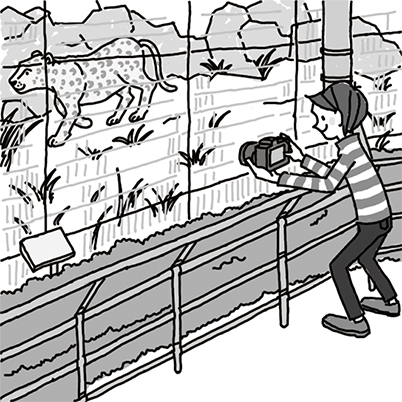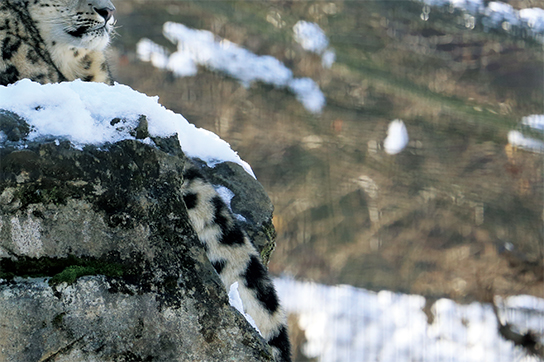Photographing animals in a zoo can be very good practice for wildlife photography. While it may not be as exciting as photographing animals in the wild, it provides a controlled environment where you can practice your telephoto lens techniques and observation skills, especially for exotic animals such as lions and tigers. However, the wire fences that keep us safe can be distracting when captured in the shot. Let’s find out how to make them magically disappear. (Reported by Junichi Date, Digital Camera Magazine)

EOS 5D Mark IV/ EF100-400mm f/4.5-5.6L IS II USM + Extender EF 1.4xIII/ FL: 560mm/ Shutter-priority AE (f/8, 1/250 sec, EV±0)/ ISO 2500/ WB: Auto
Your shots don’t have to scream, “I shot this in a zoo!”
Unless it’s for artistic reasons, chances are that you don’t want your zoo animal photographs to include tell-tale signs that they were taken in a zoo. Such signs include cage wires, fences, walls and other man-made objects.
Theoretically, you would achieve the perfect shot by finding a shooting position that hides such items from view, and then waiting there until the animal moves into a picture-perfect position. But in reality, the layout and design of the zoo might not allow that.
Instead, most photographers would do the following instead:
Basic steps for shooting through cage wires
1. Use a telephoto lens.
2. Set a wide aperture.
3. Move as close as possible to the cage/fence.
As long as the animal is not too near the wire fence, the telephoto lens and wide aperture will defocus the wires and make them less obvious. If the wire is thin enough, it might even disappear completely.
What made my shot successful

The main image is of the Tama Zoological Park’s resident snow leopard, Mimi. I wanted my shot of her to suggest that she was stalking prey among the grass, as if she was in the wild.
Tight framing
To remove all man-made objects from the frame, I made the composition very tight by using a teleconverter attached to a super telephoto lens. A longer lens also has a shallower depth-of-field, which makes it easier to defocus and blur out the fence wires. (More tips on framing in: Professional Composition Techniques (1): Visual Guidance, Unexpectedness, and Subtraction)
Moving as close to the fence as possible
This also helps to blur out the wires and is best combined with the next point.
Making sure the animal is not near the cage wires
If your animal is too near the cage wires that you are trying to shoot through, it’s hard to take the shot without some part of the wires being in focus. Wait for the animal to move away.
Three things to note for an even better shot
Depending on your shooting conditions, you might still see some traces of the cage wires. Here are some details to take note of when you shoot.
1. You get the best effects when it’s not too sunny
Not many photographers realise this, but light reflecting off the cage wires, such as in the example below, can make it hard to render them completely invisible. On a sunny day, there is more light, which means more reflection. I find it easier to "remove" the wires when it is at least partly cloudy.

Tip: The diffused light on a cloudy day also makes fur look softer in pictures.
2. The smaller the filter diameter, the less likely it is to pick up reflection
The filter diameter of your lens gives a very good approximation of the size of the front lens element. The larger the front element of your lens, the more likely it is to pick up light reflecting from the cage wires. If your filter diameter is smaller than the space between the wires, the wires should not be visible at all. If it is the same size or a bit bigger, any reflection will be at the edges of the image, which is easy to crop out.
Tip: Personally, I find it easiest to work with lenses with a filter diameter of no more than φ77mm.
3. Choose a dark background

You might have successfully made the fence wires invisible, but the lines could still show up in the background bokeh and make the bokeh look untidy. Choose a dark background to make this less obvious.
---
Be aware: Zoo photography and wildlife/nature photography contests
Zoo photography is quite controversial in the photography world. Some photographers feel that a photo of an animal captive in a zoo can never fully show its magnificence, and do not consider these "wildlife" photos or even "nature" photos. There are also ethical concerns about how animals in captivity are treated, especially since there are many "zoos" that are actually photography game farms.
In fact, many major wildlife photography contests (such as the Wildlife Photographer of the Year) do not accept images of captive animals, which includes zoo animals. Others, such as the National Geographic Photo Contest, don't ban zoo photos but require you to give details about where and how the shot was taken. Always read the contest rules carefully to avoid disqualification.
In any case, it is considered cheating to submit a zoo photograph, or even a staged photograph of a wild animal, and claim that it was taken in the wild. Contests will also want the image to be obtained ethically, which means you should not harm the animal or make it suffer so that you get your shot.
Here's an article from National Geographic that you might find useful: How to Photograph Animals Ethically
Happy shooting!
----
For more tips on zoo photography, check out:
7 Useful Tips for Taking Photos at the Zoo with a Mirrorless/DSLR Camera
5 Ways to Practise Your Wildlife Photography
How to Photograph Zoo Animals at Night
Here are some tips that will be useful for both zoo and wildlife photography:
Pro Techniques for Using the EOS 7D Mark II – Wildlife
Wildlife in Motion through Shutter Speed Control
Receive the latest update on photography news, tips and tricks.
Be part of the SNAPSHOT Community.
Sign Up Now!About the Author
A monthly magazine that believes that enjoyment of photography will increase the more one learns about camera functions. It delivers news on the latest cameras and features and regularly introduces various photography techniques.
Published by Impress Corporation
Born in Hiroshima in 1962. Graduated from the Department of Image Science, Faculty of Engineering, Chiba University. Besides his career as a photographer such as for magazines, Date is also involved actively in writing using his expertise.



































